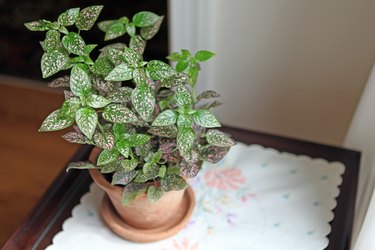
Fortunate is the gardener who lives within the boundaries of U.S. Department of Agriculture plant hardiness zones 10 and 11 and is looking for an attractive shade-tolerant plant. The polka dot plant (Hypoestes phyllostachya) is hardy in your winters, so you can grow it outdoors. The limited range, however, doesn't stop others from growing the charming plant, as it does well as a coffee table plant indoors, too. Wherever you choose to grow it, the polka dot plant, with its white and pink-freckled foliage, adds charm and requires only moderate care in return.
Things You'll Need
Humidifier (optional)
Measuring spoons
1-gallon container
Planting container (optional)
Sand (optional)
Video of the Day
How to Care for a Polka Dot Plant
Step 1: Place It in Indirect Sunlight
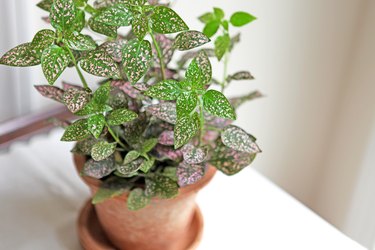
Grow the polka dot plant in an area that receives indirect sunlight. The color of the foliage brightens with more sunlight, but direct sun may burn it. Outdoors, a spot beneath a tree where it receives dappled sunlight works well. Indoor growers have the best results by placing the polka dot plant 3 or 4 feet away from a window. If the plant's leaves curl, provide it with more shade.
Video of the Day
Step 2: Water According to Needs
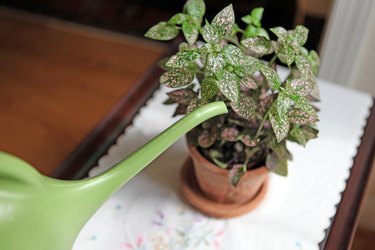
Water the polka dot plant often enough to keep the soil slightly moist. Decrease the frequency of watering if the leaves turn yellow and fall from the plant. Water more often if the leaves fall without turning yellow or it starts to wilt.
Step 3: Apply Monthly Fertilizer for Outdoor Plants
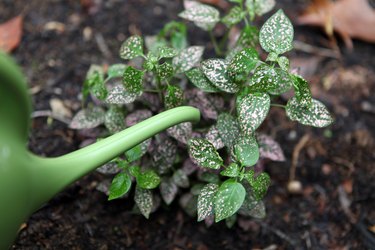
Fertilize the outdoor-grown polka dot plant once a month during the growing season. Use a balanced fertilizer, such as 20-20-20. Use 1/2 teaspoon of the fertilizer dissolved in 1 gallon of water and pour it over the soil around the polka dot plant.
Step 4: Apply Houseplant Fertilizer
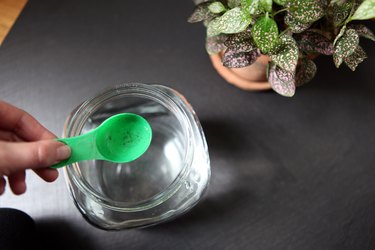
Feed an indoor plant every two weeks with the same type of fertilizer but dilute 1/4 teaspoon in 1 gallon of water and pour the solution over the soil.
Step 5: Trim Growing Tips
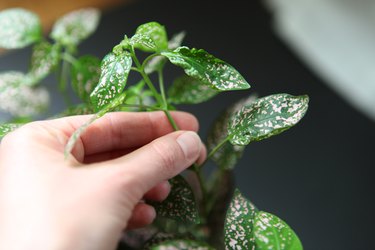
Use your fingers to pinch 1/2 inch from the growing tips periodically throughout the season. This encourages the polka dot plant to produce lateral stems, which makes the plant bushier.
Step 6: Watch for Pests
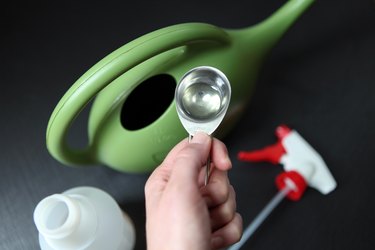
Inspect the pink plant occasionally for whiteflies, aphids, spider mites, and scale. Isolate the infested plant from others to avoid spreading the pests and use your fingers to pinch out the infested parts of the plant. The least toxic remedy for these pests is horticultural oil spray. Dilute 1 1/4 tablespoon of the oil in 1 gallon of water and spray all parts of the plant, including the undersides of the leaves.
Tip
The polka dot plant typically lives only two years indoors, so stick cuttings in a pot of sand, keep them moist, and you’ll have a new plant to replace the old one.
The polka dot plant prefers an environment with high humidity. Use a humidifier indoors to increase the humidity near the plant.
Polka dot plants are sometimes prone to powdery mildew, showing up on the foliage as white masses resembling powder. Leaf drop, distorted leaves, and stunted plant growth can occur. Treat severe outbreaks by spraying the entire plant with horticultural oil, mixed at a rate of 1 1/4 teaspoons of oil in one gallon of water. If required, repeat treatments weekly.
Warning
Although considered nontoxic by the ASPCA, the polka dot plant may cause mild diarrhea and vomiting if ingested by your pet.